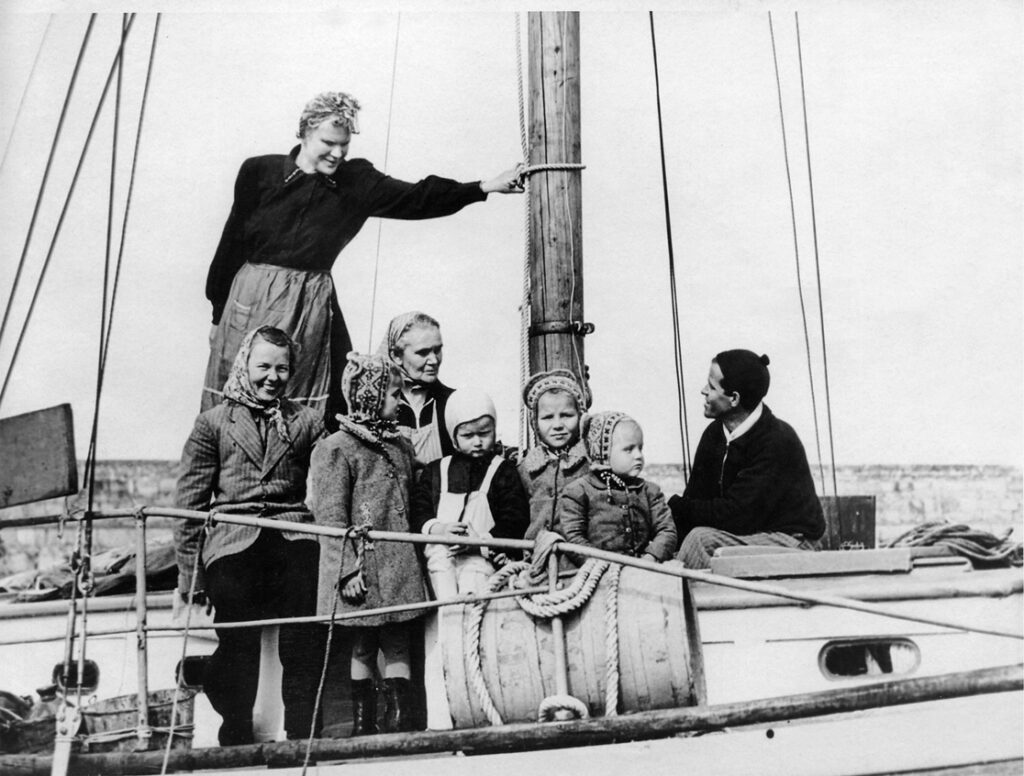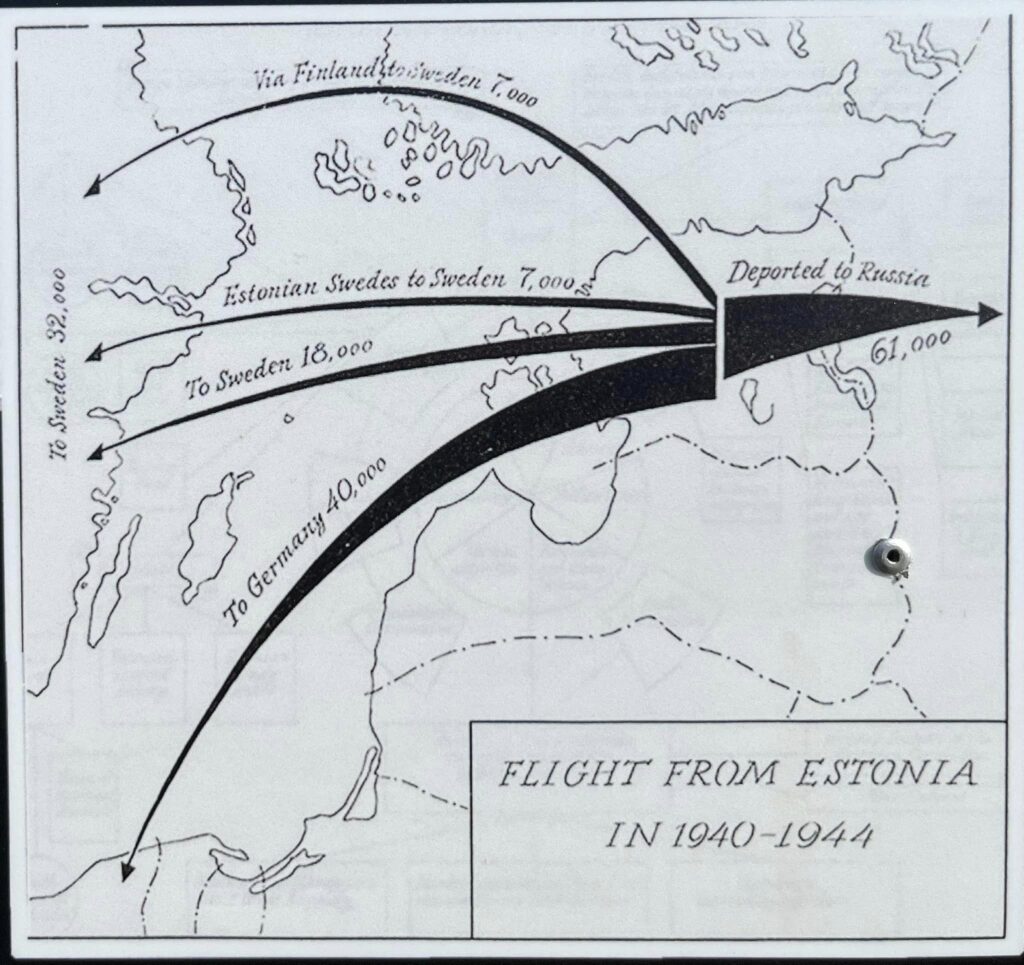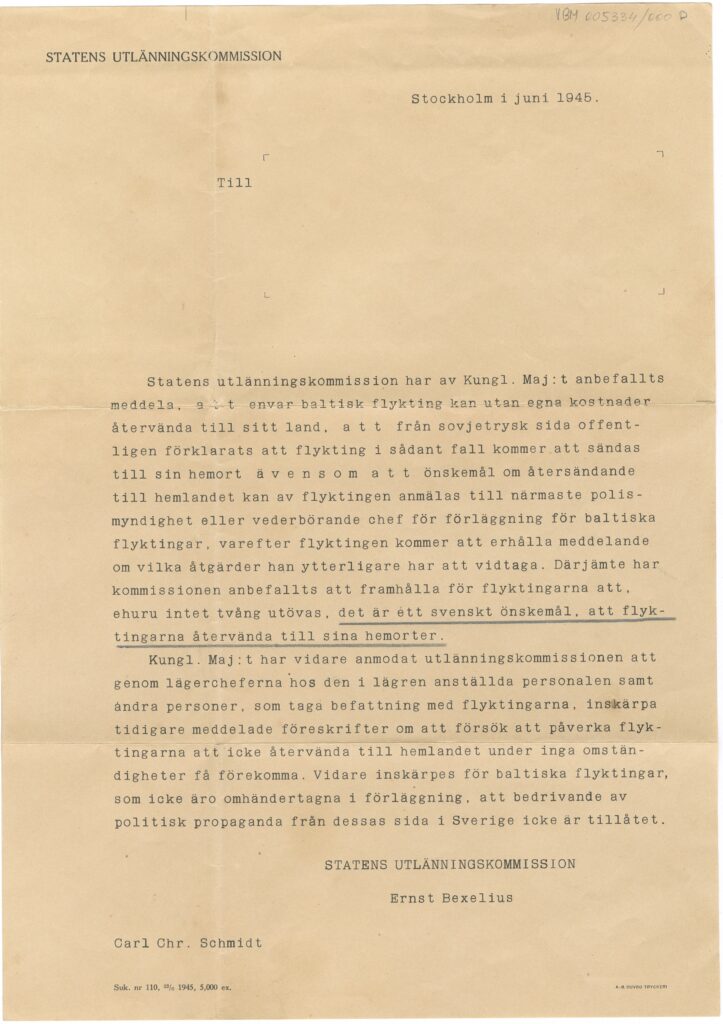FRIA VINDAR
Efter andra världskriget flydde estniska flyktingar från Sverige i små båtar över Atlanten. Upptäck hur och varför de riskerade allt för att få leva i frihet.
FRIA VINDAR

1945 förde Erma, en 11.2-meter lång slup, 16 ester över Atlanten till Amerika. Deras resa finns återberättade i boken Segla för livet, som blev en internationell bästsäljare.
Denna utställning uppmärksammar de extraordinära resorna som gjordes av tusentals estländare, i hemlighet på flykt från Sverige i slutet av 1940-talet. I gamla, slitna båtar seglade de över Atlanten till frihet.
Flyktingarna hade redan flytt en gång tidigare från sitt hemland. Under hösten 1944, samtidigt som den nazityska ockupationen föll samman och den sovjetiska armen avancerade genom Baltikum, trängde tiotusentals estländare ihop sig ombord små båtar på flykt till Sverige. Flyktingarna trodde att de hade nått säkerhet, men snart därpå började Sovjetunionen göra påtryckningar på Sverige att skicka tillbaka de baltiska flyktingarna. Efter att ha överlevt det första året av sovjetisk terror, 1940-1941, då sovjeterna fängslade, mördade och deporterade 20 000 ester, hade flyktingarna en föraning om vad som skulle ske ifall de återvände.
Eftersom de föredrog att välja sitt eget öde, slog esterna ihop sina pengar för att köpa och reparera gamla båtar, och seglade i hemlighet så långt bort som möjligt från Sovjetunionen. Utan kommunikationsutrustning ombord tillbringade besättningen timmar med att undersöka havet för minfält och sovjetiska patrullskepp på Nordsjön.
Kaptener navigerade genom stormar i den förrädiska Biscayabukten endast med hjälp av gammaldags kartor, sextanter och stjärnorna för att hitta vägen. Eftersom det var svårt och dyrt att få tag på dieselbränsle, tog båtarna hjälp av de atlantiska passadvindarna som fört Christopher Columbus fartyg till Amerika 450 år tidigare.
Nyhetstidningarna kallade skeppen för ”Vikingabåtar”, detta eftersom de kom från Sverige och till följd av att majoriteten av dem, tack vare skickliga besättningar, nådde sina destinationer. “Ingen, förutom vikingarna, har kommit i en så liten båt,” uttryckte en förundrad kanadensisk tjänsteman när båten Astrid lade till i Québec år 1948 med 29 personer ombord.
Mellan 1945 och 1951 lämnade omkring 47 skepp Sverige. Åtminstone 17 fartyg nådde USA, 11 kom fram till Kanada, sju seglade till Argentina, två till Brasilien och ytterligare tre till Sydafrika. Esterna organiserade majoriteten av de osanktionerade resorna, men letter och andra nationaliteter var också befäl och passagerare ombord skeppen. Ett flertal båtar tvingades avsluta sina resor tidigt och andra sjönk troligtvis, men eftersom båtarnas resor var olagliga och hade organiserats i hemlighet saknas exakta antal.
Utställningen “Fria vindar” baseras på Jüri Vendlas bok Unustatud merereisid: Eestlaste hulljulged põgenemisreisid üle Atlandi 1940. aastate teisel poolel (Glömda sjöresor: Den vågade flykten av ester över Atlanten i slutet av 1940-talet). Boken är den enda heltäckande redogörelsen över de baltiska flyktingbåtarna. Då den publicerades 2010, uttryckte Vendla att sovjetisk censur hade bidragit till att förtrycka denna tidsperiod i estnisk historia, och efterfrågade vidare forskning, något som denna utställning försöker åtgärda.
Var god kontakta lisa.trei@vabamu.ee med ny information, kommentarer eller rättelser.
Än idag fortsätter flyktingar att trotsa havet, ofta i icke-sjödugliga och farliga överfyllda båtar. “Fria vindar” är dedikerad till alla de människor som har tvingats fly sina hemland i jakt på säkerhet och trygghet. Speciellt tillägnas den de ukrainska flyktingar som, sedan Rysslands fullskaliga invasion av deras hemland 2022, har funnit en tillflyktsort i självständiga Estland, Lettland och Litauen.
Varför lämnade de baltiska flyktingarna Sverige?

Estland förlorade en femtedel av sina medborgare under andra världskriget. Kartan på bilden visar hur 61 000 personer deporterades, mobiliserades in i den sovjetiska armén eller, antingen frivilligt eller under tvång, evakuerades österut. Ytterligare 80 000 människor flydde väst, främst till Tyskland och Sverige.
Mellan 1943 och 1945 flydde omkring 27 000 ester, 4000 letter och 500 litauer i små båtar över havet till Sverige. Omkring 40 000 ester flydde även till Tyskland och 7000 till Sverige via Finland. Många av flyktingarna kom till Sverige med endast de kläder de hade på sig. De placerades i flyktingläger, gavs jobb och behandlades generellt väl av sina svenska värdar. Efter hand integrerades de i det svenska samhället.
Sverige var officiellt ett neutralt land under andra världskriget, men 1940 erkände landet den illegala sovjetiska annekteringen av de baltiska staterna. När Sovjetunionen åter igen ockuperade länderna efter den Nazityska regimens kollaps, såg den nya regimen alla de människor som hade flytt efter 1940 som sovjetiska medborgare, och ville att de skulle återvända.
Den svenska regeringen tillät ester som arbetade för den sovjetiska ambassaden att besöka flyktingläger och organisera återvändningskampanjer. Den sovjetiska ambassadpersonalen delade ut flygblad med titlar som Uuesti kodumaal (Hem igen) och Tõde kodumaalt (Sanningen från hemlandet).

Notis som publicerades i Dagens Nyheter 20 maj 1945, där det tillkännagavs att den sovjetiska ambassaden i Stockholm hade börjat organisera återvändandet av “sovjetiska medborgare” från Sverige.
Dessa flygblad var fyllda av lysande propaganda om livet i Sovjetestland. Återvändare garanterades bostad, anställning och även amnesti om de hade arbetat för tyskarna. Men efter traumat från den första sovjetiska ockupationen 1940-41, då omkring 20 000 ester mördades, fängslades och deporterades till Sibirien, var det få som trodde på propagandan och valde att återvända.
Flyktingarnas rädsla späddes på den 20 maj 1945, då Dagens Nyheter publicerade följande notis på svenska, ryska, estniska och lettiska, om att repatriera “sovjetiska medborgare”:
“Sovjetunionens Legation i Sverige tillkännager, att den har inlett ett organiserat avsändande av alla i Sverige befintliga sovjetmedborgare till hemlandet.
I samband härmed åligger det alla sovjetmedborgare att infinna sig vid samlingspunkterna – HAGASTRÖM) sex kilometer från staden GÄVLE), LISMA (i närheten av STUVSTA järnvägsstation), eller på Sovjetunionens Konsulat, adr. Birger Jarlsgatan 110, Stockholm. Mottagning varje dag kl. 9-18.
Personer, som av olika anledningar ej är i stånd att inställa sig personligen, kan skriftligen meddela Konsulatet, när de kan avresa till hemlandet. De skall därvid ange sin adress.
I samband med talrika förfrågningar från i de baltiska republikerna tidigare bosatta sovjetmedborgare om vart de kommer att sändas efter återkomsten till Sovjetunionen, förklarar Legationen, att de alla – enligt en förordning av Sovjetunionens Regering – sändes direkt till sina republiker (till Estland, Lettland, Litauen).”

Med stöd från Sveriges kung, skickade statens utlänningskommission brev till de baltiska flyktingarna där de rekommenderade dem att återvända till sina hemländer. Den kända fotografen Donald Koppel var en av dem som mottog brevet, och till följd av detta valde han att lämna Sverige ombord skeppet Inanda, med riktning mot USA. Koppel donerade breven på estniska och svenska till Vabamus samlingar.
